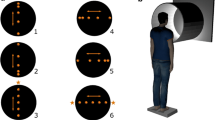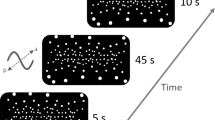Summary
Visually induced linear motion sensation (linear vection) was obtained by projection of a visual scene moving linearly in a sagittal plane at the periphery of the visual field of healthy subjects standing erect on a force platform. This linear vection induces postural readjustments characterized by an inclination of the subject, in the same direction as the movement of the visual scene, followed by an after-effect. The amplitude of the postural changes was: a) logarithmically proportional to the image velocity and the density (or the spatial frequency) of the image pattern, at highest image velocities there was a saturation of the postural effect due to limits in image motion perception and not to biomechanical constraints; b) dependent appreciably on the size of the moving scene and its relative location (in the visual field).
The frequency analysis of postural readjustments showed a) an increase of the amplitude of postural sway, especially at the low frequencies (from 0.02–0.2 Hz); b) sharp peaks in the power spectrum located between 0.15 and 0.5 Hz.
From the dynamic relationships between the velocity of the moving visual scene and the amplitude of sway, it was concluded that the postural readjustment is proportional to a low pass filtering of the logarithm of the velocity. The contribution of Tibialis Anterior and Soleus was to oppose the body inclination with a resistive force.
These results are analyzed in regard to the current theories concerning visual, vestibular and preceptive interaction in postural mechanisms.
Similar content being viewed by others
References
Amblard, B., Cremieux, J.: Role of the visual motion information in the maintenance of postural equilibrium in man. Agressologie 17, C, 25–36 (1976)
Basmajian, V.J.: Muscles Alive. Baltimore: The Williams and Wilkins Co 1967
Berthoz, A., Pavard, B., Young, L.R.: Rôle de la vision périphérique et interactions visuo-vestibulaires dans la perception exocentrique du mouvement linéaire chez l'homme. C. R. Acad. Sci. (Paris) 278, Série D 1605–1608 (1974)
Berthoz, A., Pavard, B., Young, L.R.: Perception of linear horizontal self-motion induced by peripheral vision (linear vection). Basic characteristics and visual-vestibular interactions. Exp. Brain Res. 23, 471–489 (1975)
Bischof, N.: Optic-vestibular orientation to the vertical. In: Vestibular System Part 2: Psychophysics, Applied Aspects and General Interpretations (ed. H.H. Kornhuber), pp. 155–190. Berlin-Heidelberg-New York: Springer 1974
Brandt, T., Dichgans, J., Koenig, E.: Differential effects of central versus peripheral vision on egocentric and exocentric motion perception. Exp. Brain Res. 16. 476–491 (1973)
Brandt, T., Wist, E., Dichgans, J.: Foreground and background in dynamic spatial orientation. Perception and Psychophysics 17, 5, 497–503 (1975)
Dallos, P.J., Jones, R.W.: Learning behavior of the eye fixation control system. IEEE Trans. Autom. Control AC-8, 218–227 (1963)
Davis, W.J., Ayers, J.L.: Locomotion: Control by Positive-feedback optokinetic responses. Science 177, 183–185 (1972)
De Wit, G.: Optic versus vestibular and proprioceptive impulses measured by posturometry. Agressologie 13B, 75–79 (1972)
Dichgans, J., Held, R., Young, L.R., Brandt, T.: Moving visual scenes influence the apparent direction of gravity. Science 178, 1217–1219 (1972)
Dichgans, J., Korner, F., Voigt, K.: Vergleichende Skalierung des afferenten und efferenten Bewegungssehens beim Menschen: Lineare Funktionen mit verschiedener Anstiegssteilheit. Psychol. Forsch. 32, 277–295 (1969)
Dichgans, J., Mauritz, K.H., Allum, J.H.J., Brandt, T.: Postural sway in normals and atactic patients: Analysis of the stabilizing and destabilizing effects of vision. Proc. 3rd Int. Cong. of Posturography, 1975, Agressologie 17, C, 15–24 (1976)
Dichgans, J., Wist, E., Diener, H.C., Brandt, T.: The Aubert-Fleisch Phenomenon: A temporal frequency effect on perceived velocity in afferent motion perception. Exp. Brain Res. 23, 529–534 (1975)
Diener, H.C., Wist, E.R., Dichgans, J., Brandt, T.: The spatial frequency effect on perceived velocity. Vision Res. 16, 169–176 (1976)
Edwards, A.S.: Body sway and vision. J. exp. Psychol. 36, 526–535 (1946)
Eklund, G., Lofstedt, L.: Biomechanical analysis of balance. Med. and Biol. Engrg. 23, 333–337 (1970)
Gibson, J.: The visual perception of objective motion and subjective movement. Psychol. Rev. 61, 304–314 (1954)
Gurfinkel, V.S.: Physical foundations of the stabilography. Agressologie 14, C, 9–14 (1973)
Gurfinkel, V.S., Elner, A.M.: On two types of static disturbances in patients with local lesions of the brain. Agressologie 14, D, 65–72 (1973)
Gurfinkel, V.S., Lipshitz, M.I., Popov, K.E.: Is stretch reflex base mechanism in system of orthograde postural regulation in man? Biofizika 19, 744–748 (1974)
Held, R., Dichgans, J., Bauer, J.: Characteristics of moving visual scenes influencing spatial orientation. Vision Res. 15, 357–365 (1975)
Holst, E. von: Die Arbeitsweise des Statolithenapparates bei Fischen. Z. vergl. Physiol. 32, 60–120 (1950)
Houtz, S.J.: Influence of gravitational forces on function of the lower extremity muscles. J. appl. Physiol. 19, 999–1004 (1964)
Joseph, J., Nightingale, A.: Electromyography of muscles of posture: leg muscles in males. J. Physiol. (Lond.) 117, 484–491 (1952)
Kennedy, R.S., Yessenow, M.D., Wendt, G.R.: Magnitude estimation of visual velocity. J. Psychol. 82, 133–144 (1972)
Lee, D.N., Lishman, J. D.: Visual proprioceptive control of stance. J. Human Movement studies (in press) 1975
Lee, D.N., Aronson, E.: Visual proprioceptive control of standing in human infants. Percept. and Psychophysics 15, 529–532 (1974)
Lestienne, F.: Programme moteur et mécanismes de l'arrêt d'un mouvement monarticulaire. Thèse d'Etat, Lille, 1 vol., 200 p. 1974
Lestienne, F., Berthoz, A., Mascot, J.C., Koitcheva, V.: Postural effects of visually induced linear motion sensation; Proc. 3rd Int. Cong. of Posturography, 1975. Agressologie 17, C, 37–46 (1976a)
Lestienne, F., Soechting, J., Berthoz, A.: Postural reorganizations induced by linear movement of a visual scene. Abstract, 3rd International Symp. on Motor Control. Albena: May 1976. (1976b)
Lishman, J.R., Lee, D.N.: The autonomy of visual kinaesthesis. Perception 2, 287–294 (1973)
Mach, E.: Grundlinien der Lehre von den Bewegungsempfindungen. 129 pp. Leipzig: Engleman 1875
Michael, J.A., Melville Jones, G.: Dependence of visual tracking capability upon stimulus predictability. Vision Res. 6, 707–716 (1966)
Nashner, L. M., Boylls, C. C.: Coordination of long-latency (FSR) reflex responses among muscles of the leg during stance posture control in humans. Neuroscience Abstracts, 5th Annual Meeting. Society for Neuroscience, 163 (1975)
Nashner, L.M., Berthoz, A.: Visual contribution to rapid motor responses during postural control. Abstract to International Congress of Physiological Sciences. Paris 1977
Pavard, B.: Perception du mouvement linéaire chez l'homme. Thèse 3ème cycle, Paris, 1 vol., 70 p. 1975
Roberts, T.D.M.: Neurophysiology of Postural Mechanisms. 354 pp. London: Butterworth 1967
Scott, D.E., Dzendolet, E.: Quantification of sway in standing humans. Agressologie 13B, 35–38 (1972)
Stark, L., Vossius, G., Young, L.: Predictive control of eye tracking movements. IEEE Trans. Human Factors Electron. HFE-3, 52–57 (1962)
Travis, R.C.: An experimental analysis of dynamic and static equilibrium. J. exp. Psychol. 35, 216–234 (1945)
Witkin, H.A.: Studies in space orientation. I. Perception of the upright with displaced visual fields. J. exp. Psychol. 38, 325–337 (1948)
Witkin, H.A.: Perception of the upright when the direction of the force acting on the body is changed. J. exp. Psychol. 40, 93–106 (1950)
Author information
Authors and Affiliations
Rights and permissions
About this article
Cite this article
Lestienne, F., Soechting, J. & Berthoz, A. Postural readjustments induced by linear motion of visual scenes. Exp Brain Res 28, 363–384 (1977). https://doi.org/10.1007/BF00235717
Received:
Issue Date:
DOI: https://doi.org/10.1007/BF00235717




